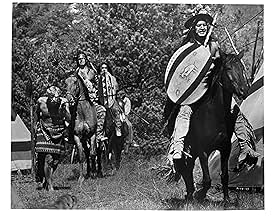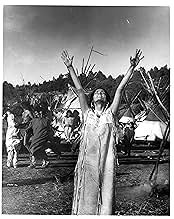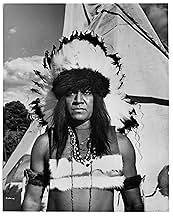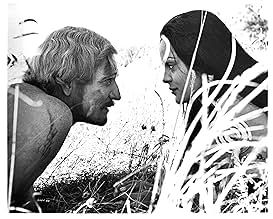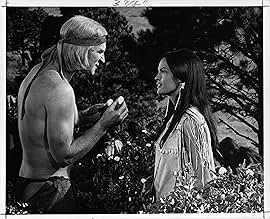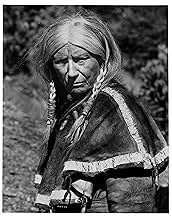IMDb RATING
6.8/10
9.8K
YOUR RATING
In 1825, an English aristocrat is captured by Native Americans. He lives with them and begins to understand their way of life. Eventually, he is accepted as part of the tribe and aspires to ... Read allIn 1825, an English aristocrat is captured by Native Americans. He lives with them and begins to understand their way of life. Eventually, he is accepted as part of the tribe and aspires to become their leader.In 1825, an English aristocrat is captured by Native Americans. He lives with them and begins to understand their way of life. Eventually, he is accepted as part of the tribe and aspires to become their leader.
- Director
- Writers
- Stars
- Awards
- 1 win & 2 nominations total
Judith Anderson
- Buffalo Cow Head
- (as Dame Judith Anderson)
Lina Marín
- Thorn Rose
- (as Lina Marin)
- Director
- Writers
- All cast & crew
- Production, box office & more at IMDbPro
Featured reviews
This is the story of Lord John Morgan, an honest earthy person who is captured by the Sioux in 1825. Abused and treated as an animal he comes to adapt to his life in order to survive. Enduring torture and oppression he must earn their respect in order to be accepted as part of their tribe.
The white man as part of a Sioux tribe story was given a major shot in the arm with Kevin Costner's Oscar bagger, Dances With Wolves in 1990. This picture came out some twenty years before Costner's stylish picture but the two films couldn't be further apart in terms of story telling. Here in Elliot Silverstein's picture, the scenery and scope is certainly lush, but the niceties stop there for this is a harsh, at times painful, story with realism dripping from each frame. Silverstein wanted to get as close as he could to the facts of the Sioux way of life, even bringing in a Sioux historian to oversee the production.
The Sioux are painted on both sides of the canvas, on one side we are shown them to be violent, even sadistic, but Silverstein also portrays them as an intelligent race driven on by intense loyalty to their ways and culture. Richard Harris plays our main protagonist and has a clear license to act with immense verve and vigour, it's a memorable turn that lingers long after the credits roll. Hurting the film is a twee romance between Morgan and the Chiefs daughter (Judith Anderson) and Jean Gascon's fluctuating accents start to grate entering the film's last quarter. But really the plus points far outweigh the little irritants in the piece. The editing from Philip W. Anderson & Michael Kahn is like a whirling paean to hallucinations, and some scenes are from the top draw, most notably the Vow To The Sun ritual that literally is painful to watch. A Man Called Horse may well be of its time, but it's certainly a very interesting and highly intelligent film. 7/10
The white man as part of a Sioux tribe story was given a major shot in the arm with Kevin Costner's Oscar bagger, Dances With Wolves in 1990. This picture came out some twenty years before Costner's stylish picture but the two films couldn't be further apart in terms of story telling. Here in Elliot Silverstein's picture, the scenery and scope is certainly lush, but the niceties stop there for this is a harsh, at times painful, story with realism dripping from each frame. Silverstein wanted to get as close as he could to the facts of the Sioux way of life, even bringing in a Sioux historian to oversee the production.
The Sioux are painted on both sides of the canvas, on one side we are shown them to be violent, even sadistic, but Silverstein also portrays them as an intelligent race driven on by intense loyalty to their ways and culture. Richard Harris plays our main protagonist and has a clear license to act with immense verve and vigour, it's a memorable turn that lingers long after the credits roll. Hurting the film is a twee romance between Morgan and the Chiefs daughter (Judith Anderson) and Jean Gascon's fluctuating accents start to grate entering the film's last quarter. But really the plus points far outweigh the little irritants in the piece. The editing from Philip W. Anderson & Michael Kahn is like a whirling paean to hallucinations, and some scenes are from the top draw, most notably the Vow To The Sun ritual that literally is painful to watch. A Man Called Horse may well be of its time, but it's certainly a very interesting and highly intelligent film. 7/10
at the beginning of this movie,there is a blurb about how the events portrayed are taken directly from historical documents of the period.the South Dakota Sioux Indians also had a lot of input into the movie.so,we can assume it is fairly accurate.one thing it does is show the Native American Indians as being just like any other people.this movie took awhile to get going,in my mind,but once it does,it's action packed,and it's very well acted.Richard Harris is the title character.he is a British Lord who is captured by the Sioux in the mid 1800's.first he is treated with disdain,as nothing more than a servant to the aging mother of the chief.gradually,though,things change,though,and he becomes much more.this is a very touching and heart breaking movie.it's also very thought provoking.overall,i give A Man Called Horse a 6/10
"A Man Called Horse" is a very unusual film about the west for many reasons. It's NOT set during the usual 'glory days' when most films of the type were set (1866-1880). It had no cowboys. And, it had very little dialog in English.
The film begins with a rich Englishman, John Morgan (Richard Harris), on a hunting expedition in the American West in the 1830s. He and his party are attacked by Sioux warriors and Morgan is taken prisoner by the natives. At first, he's treated like a slave and his life truly sucks. It didn't help that the only one who spoke any English in the tribe was another slave who was French...and the guy was a little nuts! Through the course of the film, however, Morgan learns to respect and even enjoy life with the Sioux and becomes an important member of the tribe. There is naturally much more to it than that but it's best you just see it for yourself.
This movie is almost like an ethnographic portrait of the Sioux and the times instead of a typical western film. The usual sorts of clichés and expectations are mostly missing. Some will hate this--some will no doubt be relieved. All I know is that I enjoyed it and liked the more intimate and native-centered approach of the film. Well made all around...though the sun ceremony is NOT for the squeamish.
The film begins with a rich Englishman, John Morgan (Richard Harris), on a hunting expedition in the American West in the 1830s. He and his party are attacked by Sioux warriors and Morgan is taken prisoner by the natives. At first, he's treated like a slave and his life truly sucks. It didn't help that the only one who spoke any English in the tribe was another slave who was French...and the guy was a little nuts! Through the course of the film, however, Morgan learns to respect and even enjoy life with the Sioux and becomes an important member of the tribe. There is naturally much more to it than that but it's best you just see it for yourself.
This movie is almost like an ethnographic portrait of the Sioux and the times instead of a typical western film. The usual sorts of clichés and expectations are mostly missing. Some will hate this--some will no doubt be relieved. All I know is that I enjoyed it and liked the more intimate and native-centered approach of the film. Well made all around...though the sun ceremony is NOT for the squeamish.
I have to laugh sometimes when I read otherwise sane comments from amateur reviewers. This film has fairly awkward productions values compared to the present, also many of the actors playing native people are very much NOT native. That aside, this is a BREAKTHROUGH movie for Hollywood circa 1970. This movie is not similiar to Dances With Wolves-it's effectively the other way around. I find it strange so many people make that comment. This movie predates the other by more than THIRTY YEARS!!! Anyway ackward production values aside the presentation of the Lakota is far from the touchy feely view Costner presented,we see the brutal side of their way of doing things also, which is as factual as what we see today just not very PC. This is a great period classic,well worth watching.
Although this film appeared to be a western for the 1970's, the story was not new. The writer, Dorothy M. Johnson, originally wrote it for the T.V. series Wagon Train (1957-65). Ralph Meeker was cast then in the Richard Harris role, and an excellent job he made of it, in his quiet way. A good story will always stand the test of time, as this proves.
Did you know
- TriviaFor his painful Vow to the Sun initiation ceremony scene, Richard Harris wore a prosthetic chest created by make-up artist John Chambers.
- GoofsWhen the Indian child fires an arrow at the two wandering enemy tribe members, the arrow tip has a black rubber sucker on it.
- Alternate versionsOld German VHS version includes many alternate/more violent takes that are not on the US DVD (whereas the version on the DVD is the same as in the US), especially the ending is almost completely recut. On the other hand the US version includes a few lines which are not in the German version.
- ConnectionsEdited into Commercial Entertainment Product (1992)
Details
- Release date
- Countries of origin
- Languages
- Also known as
- Un hombre llamado Caballo
- Filming locations
- Production companies
- See more company credits at IMDbPro
Box office
- Gross US & Canada
- $1,941,247
- Gross worldwide
- $44,000,000
- Runtime1 hour 54 minutes
- Sound mix
- Aspect ratio
- 2.35 : 1
Contribute to this page
Suggest an edit or add missing content



